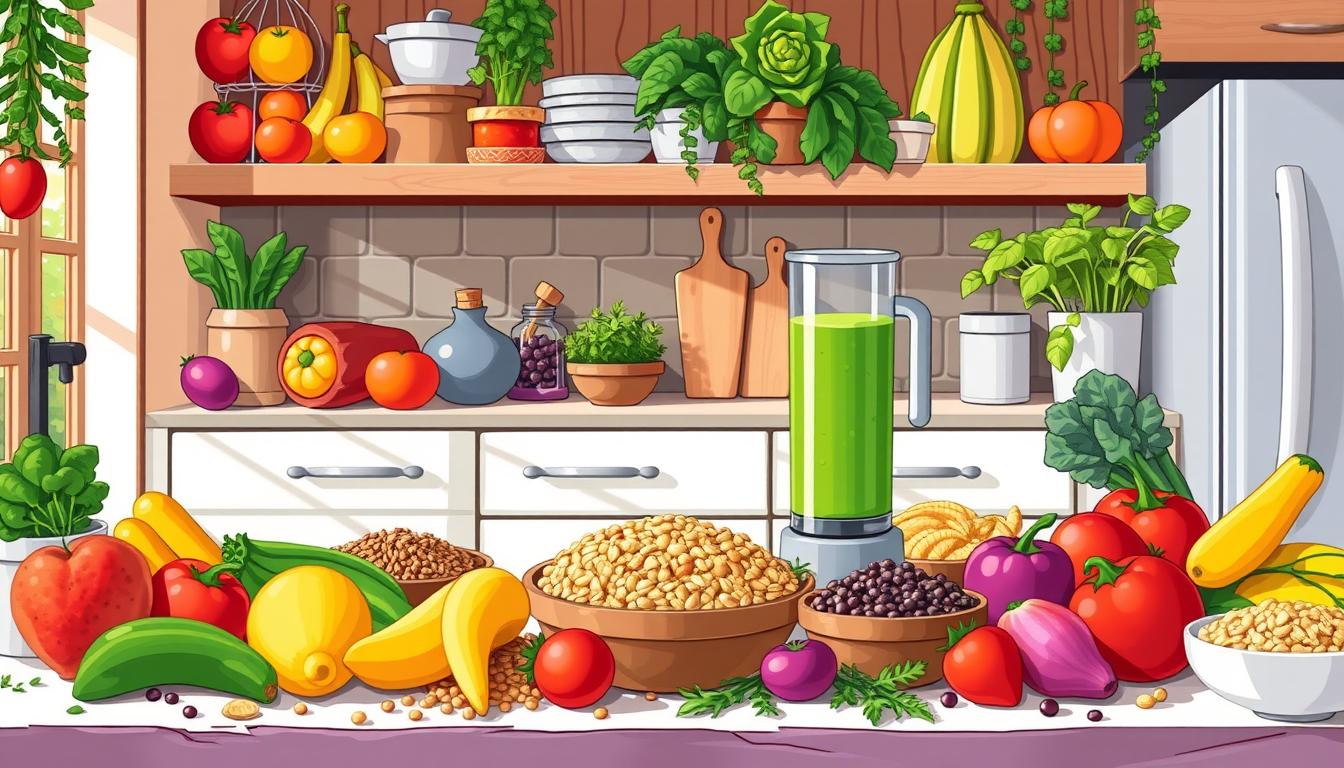The Ultimate Guide to Plant-Based Diets: Transitioning to Veganism the Right Way
Have you thought about how a plant-based lifestyle could change your health and the planet? More people are choosing veganism, and the benefits are clear. It can lower disease risks and even save you money on food.
Research shows a plant-based diet can cut heart failure risk by 42% in adults. It also improves heart health and lowers cancer risk. Plus, it helps control blood sugar for those with type 2 diabetes.
But there’s more. Vegans can save almost $750 a year compared to meat-eaters. This savings, along with health benefits, makes veganism appealing to many.
Starting a vegan diet doesn’t have to be hard. Begin with small goals and add more plant-based foods slowly. This guide will help you transition smoothly. You’ll enjoy the health benefits as you go.
Understanding Plant-Based Diets: An Introduction
Plant-based eating has become very popular lately. It focuses on foods from plants like fruits, vegetables, and nuts. People choose it for health, environmental, and ethical reasons.
What Defines a Plant-Based Diet
A plant-based diet is all about whole, natural foods from plants. It’s full of nutrients and healthy fats. Some people don’t eat animal products at all, while others might have a little bit.
The Rise in Popularity of Plant-Based Eating
Research supports the growing interest in plant-based diets. A 2021 study found they lower heart disease risk. Another study showed they help manage Type 2 diabetes better than usual diets.
Different Types of Plant-Based Diets
There are many types of plant-based diets. Each has its own rules. Here’s a quick look at some:
| Diet Type | Description | Includes | Excludes |
|---|---|---|---|
| Vegan | Excludes all animal products | All plant foods | Meat, dairy, eggs, honey |
| Vegetarian | Excludes meat and fish | Plant foods, dairy, eggs | Meat, fish |
| Flexitarian | Mostly plant-based with occasional meat | Plant foods, occasional meat | N/A |
| Pescatarian | Includes fish but no other meat | Plant foods, fish, dairy, eggs | Meat (except fish) |
Choosing plant-based eating offers many benefits. It’s good for your health and the planet. As we explore vegan nutrition and diets, you’ll see why it’s so appealing.
The Health Benefits of Adopting a Plant-Based Lifestyle
Choosing a plant-based diet can bring many health benefits. People who eat this way often feel better and have a lower risk of chronic diseases.
Plant-based diets are packed with good stuff. They have more fiber, antioxidants, and plant compounds than non-vegan diets. They also have more potassium, magnesium, folate, and vitamins A, C, and E.
One big plus is preventing diseases. Vegans might have a 15% lower risk of cancer. Eating legumes can cut colorectal cancer risk by 9-18%. Vegan diets can also lower heart disease risk by 46% by improving blood pressure and cholesterol.
- 75% lower risk of high blood pressure compared to non-vegetarians
- More effective at reducing blood sugar, LDL cholesterol, and total cholesterol levels
- May help relieve pain caused by peripheral neuropathy in diabetics
The EPIC-Oxford study looked at 33,883 meat-eaters and 31,546 non-meat eaters in the UK. It found plant-based diets are better for health. Vegans had lower heart disease risk and different cholesterol levels than meat-eaters.
While plant-based diets are great, getting the right nutrients is key. Talking to a healthcare professional can help you get the most benefits. They can make sure you’re getting all the nutrients your body needs.
Environmental Impact: How Plant-Based Diets Benefit the Planet
Plant-based diets are great for the environment. They help us eat in a way that’s good for the planet. Let’s see how a plant-based lifestyle can help our Earth.
Reducing Carbon Footprint
Choosing a plant-based diet cuts down your carbon footprint a lot. Animal farming is a big source of greenhouse gases. A study by the University of Copenhagen shows vegan diets have the lowest emissions.
Conserving Water Resources
Plant-based diets use much less water than diets full of animal products. Meat and dairy farming need lots of water. But growing fruits, veggies, and grains uses much less. By eating sustainably, we save water for everyone.
Preserving Biodiversity
Plant-based diets help keep our planet’s biodiversity. Animal farming can destroy forests and homes of animals. By eating less meat, we protect nature and its creatures.
“The food we eat can have a significant impact on our planet. Choosing a plant-based diet is one of the most effective ways individuals can reduce their environmental footprint.”
The 2021 Global Nutrition Report highlights the importance of sustainable food systems. By going plant-based, we help make our planet healthier and ensure a better future for everyone.
Ethical Considerations: Animal Welfare and Veganism
Vegan ethics are at the heart of eating with compassion. Many choose a plant-based diet to lessen animal pain and support animal welfare. This choice goes beyond food, aiming to avoid all animal exploitation.
Studies link having pets as kids to becoming vegetarians as adults, thanks to ethics. This shows that growing up with animals can shape our views on their well-being.
The effect of veganism on animal welfare is big:
- Fewer animals are raised and killed for food
- Wildlife habitats are protected
- Less predator culling happens
Veganism started in 1944 with The Vegan Society. It has since become a movement that questions how we use animals in many areas.
“The question is not, Can they reason? nor, Can they talk? but, Can they suffer?” – Jeremy Bentham
Being an ethical vegan means avoiding animal products in clothes and cosmetics. It also means boycotting shows that harm animals. This shows a strong dedication to animal rights and welfare.
As more people choose to eat compassionately, vegan product demand grows. In just a year, vegan food sales hit $3.3 billion. This shows a big change in what people want to buy.
The Ultimate Guide to Plant-Based Diets: Transitioning to Veganism the Right Way
Starting a vegan lifestyle can be thrilling but also tough. This guide provides helpful tips for a smooth transition to eating plants.
Setting Realistic Goals
Begin by setting goals you can reach. Try to cut out two animal-based foods each week and replace them with plant-based ones. Slowly add more fruits and veggies you like, and try new vegan foods too.
Gradual Transition Strategies
Going vegan step by step makes it easier. Here are some tips:
- Switch from processed meats to plant-based ones
- Cook at home to control what you eat and save money
- Plan meals ahead and prep twice a week
- Try new vegan recipes often
Overcoming Common Challenges
Dealing with vegan diet challenges is normal. Learn about vegan nutrition, join groups that support you, and try different cooking methods. There’s no one “right” way to go vegan – find what suits you best.
| Challenge | Solution |
|---|---|
| Nutrient deficiencies | Research plant-based sources of essential nutrients |
| Social pressure | Communicate your choices and find supportive friends |
| Cravings for non-vegan foods | Discover satisfying vegan alternatives |
By setting realistic goals, using gradual steps, and facing challenges, you’re ready for a successful vegan journey. Remember, being patient and persistent is crucial for this compassionate lifestyle.
Essential Nutrients in a Plant-Based Diet
A balanced vegan diet is packed with nutrients vital for health. It’s important to plan well to meet all nutritional needs. Let’s look at the main parts of a healthy plant-based diet.
Protein is key in any diet. Plant-based diets can get enough protein. Legumes, nuts, seeds, and whole grains are great sources. Eating 1 to 1.5 cups of legumes a day is good for health.
Vitamin B12 is a challenge in vegan diets. It’s not in plant foods, so fortified foods or supplements are needed. It’s wise to check B12 levels often to avoid anemia and nerve damage.
| Nutrient | Plant-Based Sources | Daily Recommendation |
|---|---|---|
| Protein | Legumes, nuts, seeds, whole grains | 10-35% of daily calories |
| Iron | Leafy greens, legumes | 18 mg for adults |
| Calcium | Fortified plant milks, leafy greens | 1000 mg for adults |
| Omega-3 | Flaxseeds, chia seeds, walnuts | 1.1-1.6 g for adults |
Iron and calcium are found in leafy greens and fortified plant milks. For heart health, add 1-2 oz of nuts daily. Omega-3 fatty acids from flaxseeds, chia seeds, and walnuts help the brain.
Studies show vegan diets can reduce chronic disease risk, improve cholesterol, and help with weight. Variety is crucial for a balanced vegan diet full of essential nutrients.
Plant-Based Protein Sources: Debunking the Protein Myth
Many people think they won’t get enough protein on a plant-based diet. But this worry is mostly not true. Studies prove that vegetarians and vegans can get enough protein from plants.
Complete Protein Combinations
Complete proteins have all nine essential amino acids our bodies need. Some plants like quinoa and soy are complete proteins. But you can also make complete proteins by mixing different plants. For instance, rice and beans together make a complete protein.
High-Protein Plant Foods
There are many vegan protein sources that are very high in protein. Legumes, nuts, and seeds are great choices. Here are some high-protein plant foods:
| Food | Protein Content |
|---|---|
| Lentils | 18g per cup |
| Chickpeas | 15g per cup |
| Peanut Butter | 8g per 2 tablespoons |
| Tofu | 20g per cup |
Calculating Your Protein Needs
The Recommended Dietary Allowance for protein is 0.8 grams per kilogram of body weight. But, this can change based on your age, how active you are, and your health. A simple meal of quinoa, black beans, and broccoli can give you 21 grams of protein. This makes it easy to meet your daily needs.
Remember, a well-planned plant-based diet can give you all the protein you need. It also offers many health benefits. By adding a variety of vegan protein sources to your meals, you can easily overcome the protein myth and do well on a plant-based diet.
Navigating Social Situations as a New Vegan
Starting a vegan lifestyle can be thrilling but also challenging in social scenes. Your vegan life doesn’t have to be lonely. With some planning and talking, you can enjoy vegan meals out and join in vegan events.
Before eating out, check the menu or call ahead for vegan choices. Many places now offer vegan options, making it simpler to find something good. At social gatherings, bring a vegan dish to share. This way, you have something to eat and show others tasty vegan food.
“Veganism is still a relatively new concept to many people, but with patience and understanding, we can create more inclusive social experiences.”
Here are some tips for navigating social situations as a new vegan:
- Communicate your dietary choices clearly and politely
- Be prepared to answer questions about your diet
- Join online and offline vegan groups for support and community
- Suggest vegan-friendly restaurants for group outings
- Host your own vegan gatherings to showcase plant-based cuisine
Remember, leading by example is often more effective than lecturing. By staying positive and flexible, you can keep a lively vegan social life. You can also inspire others to try plant-based options.
| Social Situation | Vegan Strategy |
|---|---|
| Dinner Parties | Offer to bring a vegan main dish |
| Office Potlucks | Share crowd-pleasing vegan appetizers |
| Family Gatherings | Cook traditional dishes with plant-based substitutes |
| Barbecues | Bring veggie burgers or marinated vegetable skewers |
Meal Planning and Prep for a Successful Plant-Based Journey
Vegan meal planning is crucial for a balanced diet. It helps you get all the nutrients you need. Plus, it saves time and money. Let’s look at some great ways to prep and plan your vegan meals.
Creating Balanced Vegan Meals
A good vegan meal has a mix of nutrients. Aim for these calorie percentages:
- Carbs: 45–65%
- Fats: 20–35%
- Proteins: 10–35%
Choose whole grains for carbs, nuts and seeds for fats, and tempeh, tofu, and legumes for proteins. Don’t forget to add fruits and veggies for vitamins and minerals.
Batch Cooking Techniques
Batch cooking is a big help for meal prep. Cook big batches of grains, beans, and roasted veggies at the beginning of the week. This way, you can mix and match them to make different meals all week long. It saves time and reduces stress.
Meal Prep Tools and Resources
Get good food containers, sharp knives, and a food processor to make prep easier. Use vegan cookbooks, meal planning apps, and online recipes for ideas. Simple meals like a bowl of mixed veggies, legumes, grains, and a tasty sauce can be both tasty and healthy.
| Essential Pantry Items | Meal Prep Tips |
|---|---|
| Whole grains, nuts, seeds, beans | Set time-framed goals for transitioning |
| Fresh produce, tofu, plant milks | Stock up on plant-based essentials |
| Nutritional yeast, spices, herbs | Keep a cheat sheet of protein options |
Plant-Based Substitutes for Animal Products
The world of vegan alternatives is growing fast. Almost half of big food companies now make plant-based products. This makes it easy to find dairy-free options and other substitutes. Vegan diets are becoming popular because they offer health benefits like lower heart disease risk and less chance of certain cancers.
Let’s look at some popular vegan alternatives for common animal products:
| Animal Product | Plant-Based Substitute | Uses |
|---|---|---|
| Cow’s Milk | Oat, Almond, or Soy Milk | Drinking, Cooking, Baking |
| Eggs | Flax Seed Eggs, Tofu Scramble | Baking, Breakfast |
| Cheese | Cashew-based Cheese, Nutritional Yeast | Sauces, Toppings |
| Meat | Legumes, Tofu, Tempeh | Main Dishes, Protein Sources |
For those missing cheese, Violife, Chao, and Follow Your Heart offer tasty vegan options. Cashews are great for homemade cheese and creamy sauces. When eating out, ask for plant-based choices. Many restaurants now offer more vegan options.
Starting a vegan diet can be a step-by-step process. Some people begin by eating vegetarian or try vegan meals one day a week. This gradual approach helps find satisfying vegan alternatives at your own speed.
Reading Labels: Hidden Animal Ingredients to Watch Out For
Reading vegan food labels can be tricky. Many products have hidden animal ingredients. It’s important for vegans to learn how to read labels well.
We’ll look at common animal-derived additives, vegan certification labels, and how to decode ingredient lists.
Common Animal-Derived Additives
Spotting hidden animal ingredients needs careful attention. Look out for casein, gelatin, and albumen in food products. E-numbers can be tricky, as not all are cruelty-free.
E120 (Carmine) comes from crushed beetles. Some ingredients, like glycerin, can come from plants or animals. You need to check further.
Vegan Certification Labels
Vegan product certification makes shopping easier for plant-based eaters. Stores like Sainsbury’s, Tesco’s, and Lidl use vegan labels. Look for the Certified Vegan logo or the Vegan Society’s Vegan Trademark.
These symbols mean the product is free from animal-derived ingredients.
Navigating Ingredient Lists
Reading ingredient lists carefully is crucial. Allergens like dairy and eggs are in bold. This makes them easier to find.
Be cautious of “natural flavors,” which might include animal products. If unsure, contact the manufacturer for more information.
| Product Type | Hidden Animal Ingredients | Vegan Alternatives |
|---|---|---|
| Breakfast Cereals | Vitamin D3 (from sheep’s wool) | Vitamin D2 (plant-based) |
| Sweets | Gelatin (animal collagen) | Agar-agar, pectin |
| Red-colored Foods | Carmine (crushed beetles) | Beetroot, paprika extract |
| Breads | L-cysteine (from animal hair or feathers) | Plant-based L-cysteine |
Staying Healthy on a Vegan Diet: Supplements and Considerations
A well-planned vegan diet can give you most of the nutrients you need. But, some important nutrients might be missing. That’s where vegan supplements come in. They help fill those gaps.
Vitamin B12 is one of the most important supplements for vegans. It’s not found in plant foods. Low levels of B12 can cause anemia. So, it’s key to take B12 supplements or eat fortified foods every day.
Plant-based nutrition needs careful planning. You need to make sure you get enough calcium for strong bones. Kale, collard greens, and fortified plant milks are good sources.
Iron is also crucial for making red blood cells and energy. You can find it in pulses, wholemeal products, and leafy greens. Women might need more iron because of their menstrual cycles.
Here are some vegan health tips to keep in mind:
- Check your vitamin D levels, especially if you don’t get much sun
- Think about taking algae-based omega-3 supplements for heart health
- Eat iron-rich foods like spirulina and fortified cereals
- Include calcium-rich foods such as tofu and fortified plant milks
- Add vitamin C-rich fruits and vegetables to boost your immunity
Getting regular blood tests can spot nutrient deficiencies early. Talking to a registered dietitian when you start a vegan diet is a good idea. They can make sure you’re getting all the nutrients you need. A balanced vegan diet with the right supplements supports your health and well-being.
Plant-Based Eating on a Budget: Tips and Tricks
Eating vegan on a budget is simpler than you might think. With smart planning and shopping, you can enjoy vegan meals without spending too much. Here are some tips to help you save money while eating plant-based.
Affordable vegan staples
Focus on affordable vegan staples to keep your diet budget-friendly. Stock up on dried beans, lentils, rice, and oats. These are cheap and full of nutrients. Also, add seasonal fruits and veggies to your list for variety and savings.
Shopping strategies for savings
Here are some ways to save on plant-based foods:
- Buy in bulk for non-perishable items
- Choose frozen fruits and veggies for savings and nutrition
- Plan meals to avoid impulse buys
- Look for sales with grocery store flyers
- Shop at local farmers’ markets for fresh, affordable produce
Reducing food waste
Reducing food waste is key to saving money on vegan eating. Properly store your produce to make it last longer. Use leftovers in new meals. Consider composting to reduce waste and feed your garden. Cooking at home saves money compared to eating out or buying processed vegan foods.
With these tips, you can enjoy a healthy, tasty vegan diet without overspending. A bit of planning can make your vegan journey affordable and sustainable.
Dining Out as a Vegan: Restaurant Hacks and Menu Navigation
Eating out as a vegan can be tricky, but with smart strategies, you can enjoy plant-based dining out. While 85% of vegans find it easy to eat at home, 70% face challenges at restaurants. Don’t worry! We’ve got some vegan restaurant tips to help you navigate menus like a pro.
First, do your homework. Check restaurant menus online before you go. Many places now offer vegan menu options, and some even have hidden vegan menus. Don’t be shy to call ahead and ask about plant-based choices. Apps like HappyCow can be a lifesaver for finding vegan-friendly spots nearby.
When you’re at the restaurant, be clear about your dietary needs. 90% of vegans stress the importance of direct communication with staff. Look for menu icons marking vegan dishes, or ask about modifying existing items. Remember, 80% of vegans successfully make clever substitutions to create vegan-friendly meals. With these tips, you’ll be a master at finding delicious vegan options wherever you dine!
Source Links
- The Ultimate Guide to Plant-Based Diets
- Transitioning to a plant-based diet – tips and tricks | Parkview Health
- The Beginner’s Guide to a Whole-Food, Plant-Based Diet
- A Look at Plant-Based Diets
- How to start a plant-based diet – Mayo Clinic Press
- Health Benefits of a Vegan Diet
- Plant-based diets and long-term health: findings from the EPIC-Oxford study
- Exploring Benefits and Barriers of Plant-Based Diets: Health, Environmental Impact, Food Accessibility and Acceptability
- Plant-Based Diets: Considerations for Environmental Impact, Protein Quality, and Exercise Performance
- The Ethics of Veganism
- Exploring Veganism: Ethical and Dietary Choices
- Foods for Plant-Based Diets: Challenges and Innovations
- Your Complete Guide To Plant-Based Diets
- How To Transition To Veganism: A Beginner’s Guide
- Plant-Based Diets: A Physician’s Guide
- The Safe and Effective Use of Plant-Based Diets with Guidelines for Health Professionals
- Ultimate Guide to Vegan Nutrition
- Dietary Protein and Amino Acids in Vegetarian Diets—A Review
- Plant-Based Protein: A Comprehensive Guide for Vegetarians and Vegans
- Deep Dive into Plant Based Protein (and debunking some myths along the way)
- How to go vegan
- How To Become A Vegan: The Ultimate Guide to Plant-Based Living
- Kickstart Your Vegan Journey: Beginner Tips for a Plant-Based Life
- Ultimate Guide to a Vegan Meal Plan for Weight Loss
- Your Step-By-Step Guide to Going Plant-Based
- How to Go Vegan: A Beginner’s Guide to Eating Plant-Based
- The Vegan Diet — A Complete Guide for Beginners
- How to go from vegetarian to vegan – Damn Tasty Vegan
- A vegan’s guide to reading food labels – Vegan Food & Living
- 13 Surprising Foods You Think Are Vegan But Aren’t
- How to Maintain a Balanced Diet as a Vegetarian or Vegan
- The vegan diet
- Supplementing on a Vegan Diet: The Ultimate Guide | Go Plant-Based
- 9 Healthy Tips to Help You Start Eating a Vegan Diet
- How to Transition to a Plant-Based Diet
- Beginner Tips for Eating a Plant-Based Diet – Start today!
- How to Eat Vegan at Any Restaurant (and Not Order Salad)
- 9 Tips on Eating Out as a Vegan – Sarahs Vegan Guide
- Navigating the Transition to a Plant-Based Diet – Guiding Stars







